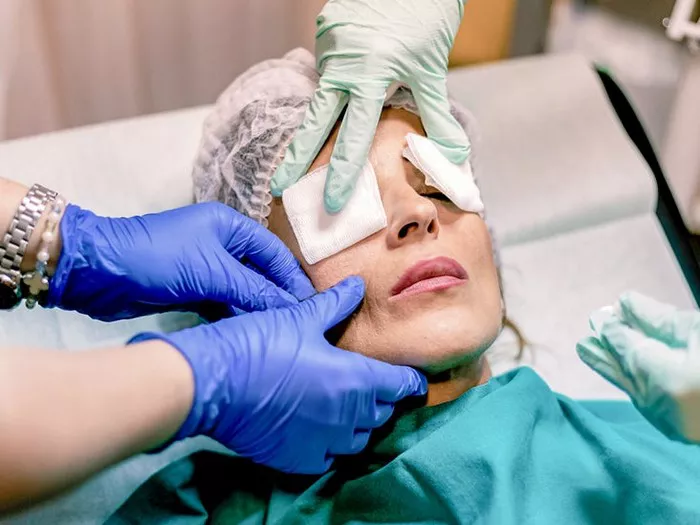Excess eyelid skin, commonly referred to as eyelid hooding or droopy eyelids, can have a significant impact on one’s appearance and even affect vision in severe cases. While aging is a natural process that contributes to this condition, there are various effective solutions available to address excess eyelid skin. This article aims to provide a comprehensive guide on managing this concern, including both non-surgical and surgical options, as well as preventive measures for maintaining healthy eyelids.
1.Understanding Excess Eyelid Skin: Causes and Symptoms
Excess eyelid skin occurs due to a combination of factors such as aging, genetics, sun exposure, and lifestyle choices. As we age, the skin loses elasticity, causing it to sag and accumulate in the upper or lower eyelids. The most common symptoms of excess eyelid skin include a heavy or tired appearance, limited peripheral vision, difficulty applying makeup, and an overall older appearance.
2.Non-Surgical Solutions:
Eyelid Exercises: Regular eyelid exercises, including eyelid massages and gentle eye movements, can help improve muscle tone and reduce the appearance of sagging eyelids. Consult with an ophthalmologist or a licensed aesthetician for specific exercises tailored to your needs.
Topical Treatments: Some over-the-counter creams and serums contain ingredients like retinol, peptides, and antioxidants, which can improve skin texture and firmness. However, the effectiveness of these products may vary, and it is essential to choose those specifically formulated for the delicate skin around the eyes.
Botox: Botulinum toxin injections, commonly known as Botox, can be used to temporarily lift the eyebrows and reduce the appearance of excess eyelid skin. By relaxing the muscles that cause hooding, Botox can create a subtle lifting effect. However, the results are temporary and require regular maintenance treatments.
Chemical Peels and Laser Resurfacing: These minimally invasive procedures can improve skin texture, stimulate collagen production, and tighten loose skin. Chemical peels involve applying a chemical solution to the skin, while laser resurfacing uses laser technology to remove damaged layers of skin. These treatments can be effective in reducing mild to moderate excess eyelid skin.
3.Surgical Options:
Blepharoplasty: Eyelid surgery, also known as blepharoplasty, is a common surgical procedure performed to remove excess skin, fat, and muscle from the eyelids. It can be performed on the upper and lower eyelids separately or combined. Blepharoplasty can restore a youthful appearance, improve vision, and enhance overall facial aesthetics. Recovery time varies, but most individuals can resume normal activities within a couple of weeks.
Brow Lift: In some cases, excess eyelid skin is associated with drooping eyebrows. A brow lift, either performed alone or in combination with blepharoplasty, can address both concerns. This surgical procedure lifts and repositions the eyebrows, reducing the appearance of excess skin on the upper eyelids. It results in a more alert, rejuvenated look.
4.Preventive Measures for Healthy Eyelids:
Sun Protection: Protecting your eyelids from harmful UV rays is crucial to maintain their health and prevent premature aging. Wear sunglasses with UV protection and apply a broad-spectrum sunscreen to the eyelids regularly.
Eyelid Hygiene: Practicing good eyelid hygiene can help prevent conditions like blepharitis, which can contribute to excess eyelid skin. Cleanse your eyelids gently with a mild, hypoallergenic cleanser and avoid harsh rubbing or pulling.
Nutrition and Hydration: A well-balanced diet rich in antioxidants, vitamins, and minerals can promote skin health. Stay hydrated by drinking an adequate amount of water each day, as dehydration can affect the skin’s elasticity.
Avoid Smoking and Alcohol: Smoking and excessive alcohol consumption contribute to premature skin aging and can exacerbate the appearance of excess eyelid skin. Quit smoking and moderate alcohol consumption for healthier skin overall.
Conclusion:
Excess eyelid skin can have a significant impact on one’s appearance and self-confidence. Thankfully, there are numerous solutions available to address this concern, ranging from non-surgical options to surgical procedures. Consulting with a qualified professional is crucial to determine the most suitable treatment plan for your individual needs. By incorporating preventive measures and considering the available options, you can achieve a refreshed, youthful look and maintain healthy eyelids for years to come.

